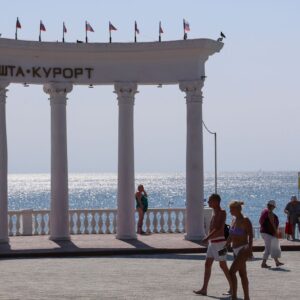Every few days, Russian occupation authorities on Ukraine’s Crimean Peninsula parade newly caught “traitors” in front of the cameras.
For some, the crime consisted of playing Ukrainian songs in public, running a pro-Ukrainian social-media account or tying yellow cloth strips, a sign of resistance to Russian rule, to fences and trees. Other detainees include shopkeepers and gas-station attendants who had refused service to Russian soldiers. Still others stand accused of more-serious acts of resistance: blowing up railroad tracks or gathering intelligence for Ukrainian missile and drone strikes.
While this crackdown is meant to cow pro-Ukraine residents of Crimea into submission, it also highlights a worrying fact for Russian occupation authorities: Despite their claims, believed by many outside Russia, that the people of Crimea solidly stand with Moscow, many Crimeans openly yearn for a return to Ukrainian rule.
Given the degree of repression, estimating the level of such support for Kyiv is impossible. Moreover, many Ukrainian citizens have fled Crimea since Russia annexed it in 2014 and hundreds of thousands of settlers from all over Russia moved to the peninsula, attracted by its beaches and subtropical weather.
But one thing is clear: The Kremlin’s decision to launch a full-out invasion of Ukraine in February 2022 has put Crimea’s future back on the table, with Russian rule no longer viewed by virtually all of the peninsula’s residents as likely permanent.
“Ukrainian citizens who live in Crimea and want the restoration of Ukrainian administration have always been numerous, but until 2022 they believed that the territory of Crimea will be occupied for a long time,” said Borys Babin, a Crimean-born Ukrainian politician who serves as an expert at the Association for the Reintegration of Crimea. “The pro-Ukrainian population has become more optimistic. These feelings are bursting to the surface, and we can see them.”
Punishments for showing these feelings are often severe, with prison terms and forced confessions that are broadcast on a Telegram channel called the Crimean Smersh—a reference to the Stalin-era abbreviation for counterintelligence death squads.
August’s catches included a man apologizing for posting “Glory to Ukraine” on social media, another for blasting a Ukrainian song about burning a Russian tank, and three young hostesses at the Alushta aquapark who had danced to another Ukrainian pop tune. The three women were made to sing on camera about the greatness of Russian President Vladimir Putin. Russia’s FSB intelligence service, meanwhile, paraded a man who had allegedly blown up a gas pipeline in Crimea, one of several such recent detentions on sabotage charges.
Most of those detained for such acts of resistance aren’t members of the traditionally pro-Ukrainian Crimean Tatar community, an estimated 12% of the peninsula’s population. Many are ethnic Russians who are repulsed by Russia’s militaristic autocracy and prefer a return to democracy under Ukrainian rule.
Seizing Crimea in 2014, as the Ukrainian army didn’t fire a shot to resist, was a major achievement for Putin, boosting his popularity at home and whetting his appetite for other parts of Ukraine……
